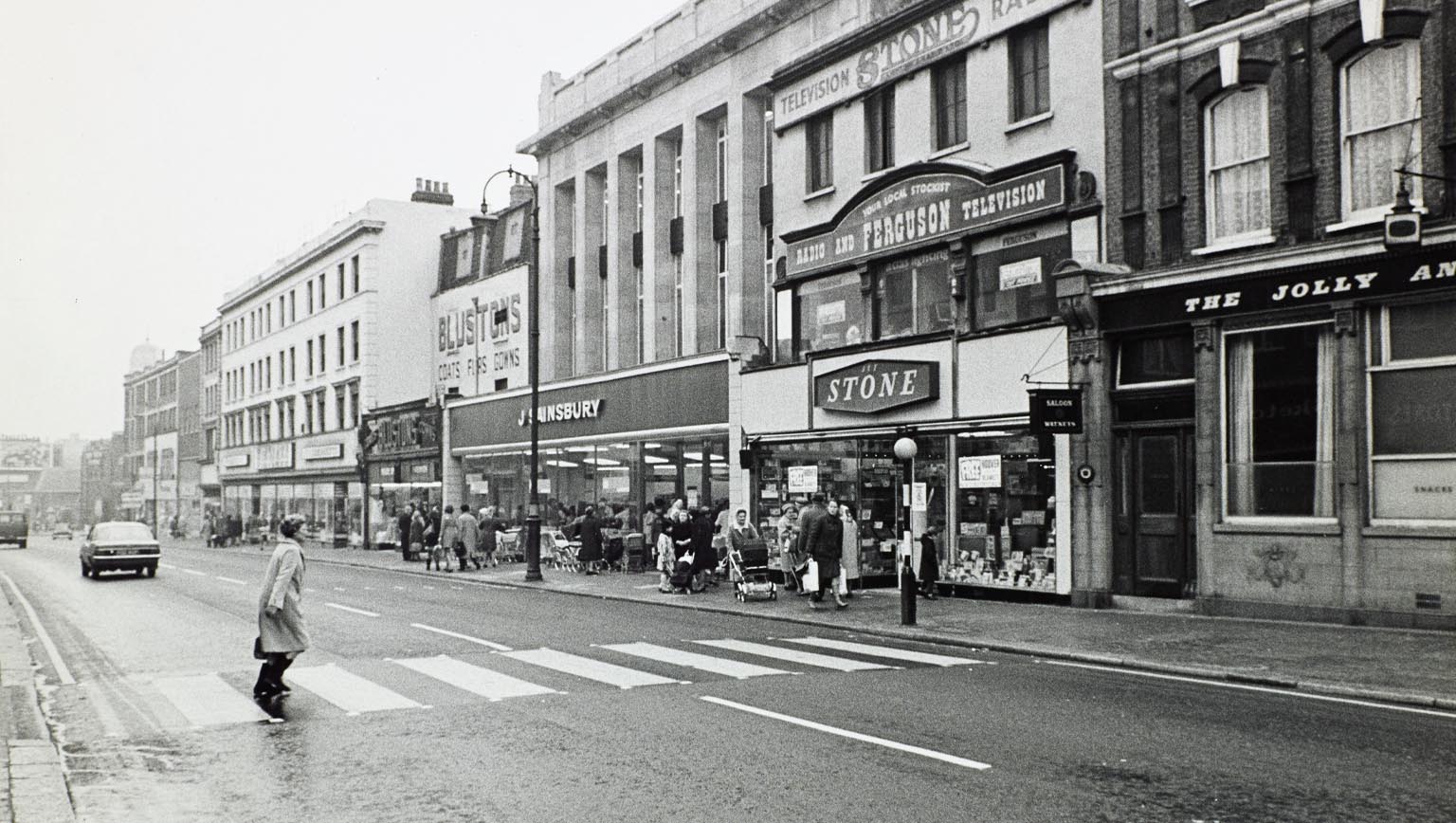
The ‘navvies’ of Chalk Farm: fist fights, rowdy pubs and raffling a dead body
Life was dangerous, drunken and relentlessly tough for the men who transformed the neighbourhood carving out the railways

For a reminder that shopping always shifts with the times – often dramatically
With the cliff-edge decline of traditional retail during the Covid lockdowns, it’s easy to forget that varying degrees of high street upheaval have been going on for hundreds of years. In this extract from the Camden History Society’s newsletter of January 1978, local historian Gillian Tindall remembers Daniels, the reliable centrepiece of Kentish Town Road for nearly a century. (It’s now in-part occupied by the Owl Bookshop, the Sainsbury’s pictured having subsequently been a Kwik-Save, Morrison’s, Co-Op and now Lidl.
Her overview of the latest names on the street 43-years-ago reveals this constant flux in the fortunes of the big high street brands of today, who open and close in the same spots, and fall in and out of favour with shoppers.
As we ponder what next for Camden’s – and the wider world’s – retail centres, the article makes for a fascinating insight into the relentless pursuit of commerce at the heart of communities everywhere.
Last summer, Kentish Town Marks & Spencers [currently Iceland in 2021] narrowly escaped being closed down for reasons that are understandable; the branch is over-shadowed by the nearby Camden Town and Holloway Road branches, both considerably larger. Though it was purpose-built in 1930, and carefully enlarged since, it has only 7000 sq. ft of floor space compared with the modern M&S average of 20,000; it has been failing either to carry a full range of goods or to pay its way for some time. But equally understandable was the reaction of local shoppers and traders – particularly the latter – who took the line that once Marks’, today’s linchpin of High Street shopping, pulled out, Kentish Town’s main thoroughfare would lose credibility all round and become a ‘ghost street’ of unlet and unlettable premises.
Whatever the rights and wrongs of the matter St Michael appeared to be touched by the fuss and was persuaded to stay – for the moment. But what is interesting to the historian in this present-day event is the relatively short time-scale of the evolution of the chain-store from interloper into institution. In the inter-war period, when empires like Marks’ (and Boots, Sainsburys Woolworths Timothy Whites and the Home and Colonial Stores) were busy staking out their territory in the high streets in and out of London they were seen as characterless, cut-price upstarts. The presiding genii of the High Streets were then the department stores each unique to its particular locality. They were still apparently in their hey-day, though a discerning shopper might have noticed that overhead cash railways, oval mirrors, bright electric lights and life-size models hardly proclaimed, any longer, a particular modernity or sophistication. But the dividing line between being attractively well-established and unattractively dowdy is always hard to discern, and Daniels – the Kentish Town Big Shop – may be forgiven for having imagined that its well-established ways would do forever.
Daniels (which occupied two large blocks on the western side of the Kentish Town Road, one of which now houses Sainsburys) could trace its origins back to 1865, the period when the district was changing rapidly and definitively from an overgrown suburban village into a piece of London. Two brothers, Charles and Alfred Daniels, who are reported rather surprisingly to have been of Essex farming stock, took the lease on a shop in Old Chapel Row (as that part of the High Street was then called) from its previous occupant, a confectioner, and opened a drapers called ‘The Little Wonder’. In fact indirect evidence in Street Directories of the time suggests that their tenancy coincided with the rebuilding of that run, replacing converted houses with purpose-built shops. A local newspaper of 1867 noted with approval the area’s changing character, including the ‘vista of large and magnificent shops, the busy appearance of the principal streets’. No doubt to eyes accustomed to the small-windowed, lattice-paned individual dairies and milliners of a still earlier period, the new commerce did indeed seem splendid. Even in Edwardian days, when it had become commonplace, the young John Betjeman saw Daniels as ‘a kind of Selfridges’.
Even in Edwardian days, when it had become commonplace, the young John Betjeman saw Daniels as ‘a kind of Selfridges’.
Gillian Tindall
Daniels achieved a fleeting national fame in the 1st World War, through being damaged in a Zeppelin raid – further rebuilding followed. At that time many of its assistants actually lived above the shop, a life of meagre pay and long hours, strictly controlled by a resident house-keeper. It kept going without mishap until and during the 2nd World War, and celebrated its 87th anniversary in 1952. (Why 87?) The Beverley sisters signed their latest record in the newly-opened television department and prizes were offered in a knitting competition. One lifelong customer brought in a packet of needles which her mother had purchased at the store in 1870, and every hundredth customer was offered a free permanent wave. But in reality the writing was on the wall for Daniels, still a family firm and by then (according to someone who worked in it in those days) ‘unbelievably old-fashioned – very disorganised. Full of enamel slop pails.’ Domestic objects could be had cheaper at Woolworths, and its most important line of business – clothing – had lost out to Burtons and to Marks & Spencer. A decade later, when Daniels centenary should have been celebrated, the building was empty. It remained so for years, though intermittent tenants came and went; it is only now, with the establishment of Owl Bookshop and several other individual tenants in the part not occupied by Sainsburys, that new life has been injected into it. Now, in tum, the cycle of the chain-stores in inner London is taking its own inexorable course. Read Camden History Society Newsletter for 1993 to find out more.
This is an extract from the newsletter of the Camden History Society, first published in January 1978. To find out more about the work of the society, its fascinating publications detailing the streets and neighbourhoods of the borough, and becoming a member, visit

Life was dangerous, drunken and relentlessly tough for the men who transformed the neighbourhood carving out the railways

The King’s Cross educational charity just keeps on growing

As a new range of tees and merch celebrates the iconic label

Lust after the luxury flats or envy the industrial chic offices